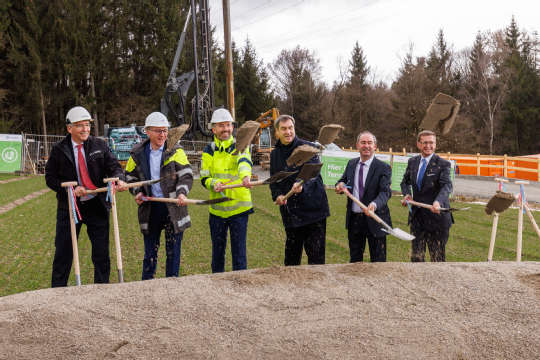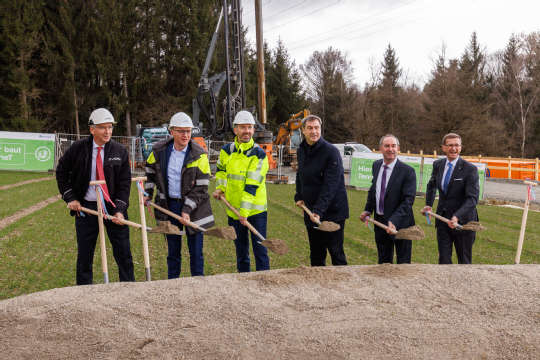Groundbreaking Ceremony for 380 kV Deutschlandleitung
The Deutschlandleitung (cross-border line between Austria and Germany) is a joint project of the two transmission system operators Austrian Power Grid AG (APG) and TenneT TSO GmbH (TenneT). On March 9, the groundbreaking ceremony for the cross-border construction section took place on the German side.
The new 380 kV Deutschlandleitung will run from St. Peter am Hart (Upper Austria) to Altheim (Bavaria). Approximately 2.5 line kilometers will run on Austrian territory and connect APG's St. Peter grid node with TenneT's Simbach, Ottenhofen, Isar and Pleinting substations in Bavaria. The start of operation of the new 380 kV line, which carries the label ‘Project of common interest’ (PCI) at European level, is scheduled for 2027.
"The groundbreaking ceremony for the Deutschlandleitung is an important milestone in our intensive efforts to integrate Austria into the European electricity market in a well-connected manner. The 380 kV line provides security through the possibility of intensive electricity exchange as well as significantly improved access for Austrian electricity customers to the European electricity market," says Gerhard Christiner, Chief Technical Officer of APG.
The TenneT ceremony was attended by "host" Tim Meyerjürgens, Managing Director of TenneT, Gerhard Christiner, Chief Technical Officer of APG, Thomas Karall, Chief Financial Officer of APG, Markus Achleitner, Member of the provincial government of Upper Austria, Hubert Aiwanger, Bavarian Minister of Economic Affairs and Markus Söder, Governor of Bavaria.
Grid at the limit
The two existing 220 kV lines from St. Peter to Bavaria were already built in the 1940s (Simbach/Altheim) and 1960s (Pirach/Pleinting). The line capacity designs chosen at that time no longer meet today's requirements. The transmission capacities are reaching their limits, which means that internationally coordinated, cost-intensive congestion management measures are increasingly necessary in this grid area. In addition, the lack of grid capacities also means that for rather long periods low-priced electricity from Germany is not available to Austrian electricity customers.
"These developments must be decisively counteracted with the expansion of the cross-border Deutschlandleitung. The high number of redispatch measures is not only a warning sign that the lines are reaching their capacity limits, but they are also a financial burden for all consumers. In 2022 alone, the costs for redispatch measures (congestion management) in this area were 718 million euros," says Gerhard Christiner.
Essential for energy exchange and the success of the energy transition
The planned 380 kV line from the St. Peter grid hub to Germany is an important prerequisite for the success of the energy transition. It connects the renewable energies wind and water: clean wind power from northern Europe can thus be transported to the storage power plants in the Alps.
"The Deutschlandleitung makes it possible to increase cross-border capacities enormously and brings Austria and Germany a big step closer in terms of their energy industries. On the one hand, this is essential to exchange renewable electricity across borders. On the other hand, it also makes cheaper electricity available for Austria, which is of key importance for consumers from industry & commerce. Currently, Austrian electricity consumers pay about 26 euros more per MWh than consumers in Germany due to the lack of grid capacity. This leads to a very concrete locational disadvantage for Austria's businesses and industry. The Deutschlandleitung therefore has a very significant economic added value and strengthens Austria as a business location in the long term," explains Christiner.
Milestone for domestic grid expansion
The Deutschlandleitung also plays an essential role for the domestic grid expansion. "APG is investing around 84 million euros in the new Cross-border line to Germany. The resulting increase in capacity and the improved energy exchange between Germany and Austria are prerequisites for the implementation of APG's modernization and expansion plans regarding the Austrian electricity infrastructure. To this end, we will invest approximately 3.5 billion euros in the domestic electricity grid by 2032. These investments will ensure a secure supply of electricity, the availability of low-priced electricity for all consumers in Austria, and the reduction of CO2 emissions," says Thomas Karall, Chief Financial Officer of APG.
International line with regional significance
The St. Peter substation in Upper Austria - where expansion work is being carried out in the course of the project - is one of the end points of the 380 kV Deutschlandleitung. As a central hub in APG's grid, the St. Peter substation therefore plays an essential role not only for ensuring a secure supply of electricity in Austria, but in particular in Upper Austria.
"For Upper Austria as a strong economic and industrial province, a secure and stable power supply is of central importance. At the same time, the switch to renewable energies is a particular priority for Upper Austria. The Altheim-St. Peter power line makes a significant contribution to achieving both goals: the higher capacities of the new ‘four-system’ 380 kV Deutschlandleitung and the upgrading work at the St. Peter substation will strengthen the existing grid support and thus the secure supply of electricity in the region. In addition, this will further accelerate the implementation of the energy transition through renewable energy generation, transformation of mobility and decarbonization of industry. This power line is therefore also an important component of the 'Upper Austrian Power Grid Master Plan', with which the expansion of the electricity grid infrastructure in Upper Austria is being consistently pressed ahead together with the grid operators," says Markus Achleitner, member of the provincial government of Upper Austria who is responsible for economic affairs.
About Austrian Power Grid (APG)
As independent transmission system operator Austrian Power Grid (APG) is in charge of ensuring the security of electricity supply in Austria. With our high-performance and digital electricity infrastructure and the use of state-of-the-art technologies we integrate renewable energies, we are the platform for the electricity market, we provide access to reasonably priced electricity for Austria’s consumers and thus create the basis for Austria as supply-secure industrial and business location and place to live. The APG grid totals a length of about 3,400 km and is operated, maintained and continuously adapted to the increasing challenges of the electrification of businesses, industry and society by a team of approximately 733 specialists. Also in 2022 Austria had a security of supply of 99.99 percent and thus ranks among the top countries worldwide. Our investments of 490 million euros in 2023 (2022: 370 million euros) are a motor for the Austrian economy and a crucial factor in reaching Austria’s climate and energy targets. Until 2032 APG will invest a total of approximately 3.5 billion euros in grid expansion and renovation projects, which amounts to approximately 19 percent of the total of 18 billion euros which the energy industry will invest in the grid infrastructure over the next ten years.
Press contact
Stefan Walehrach


